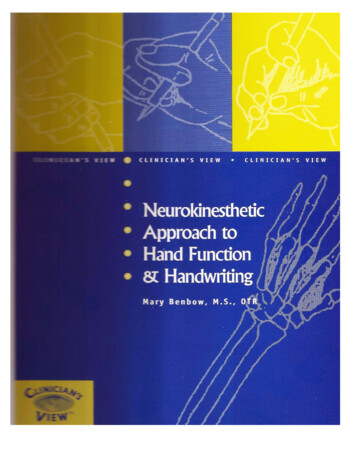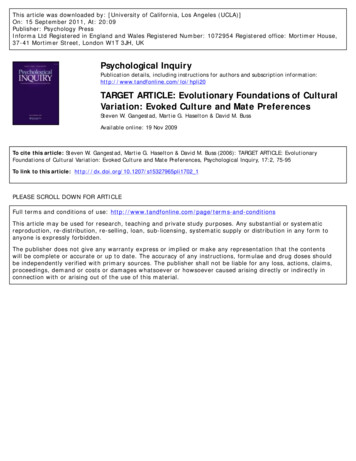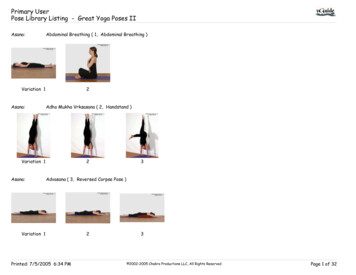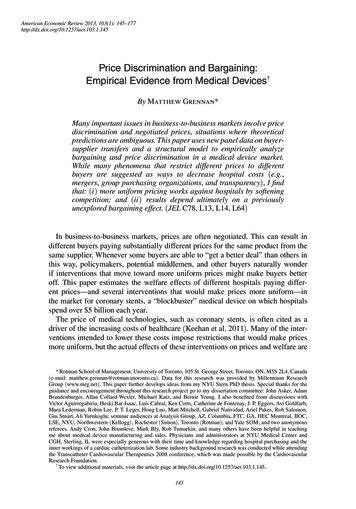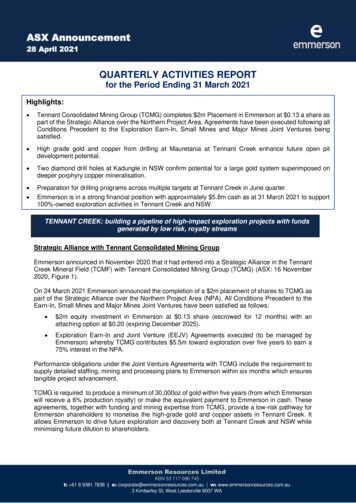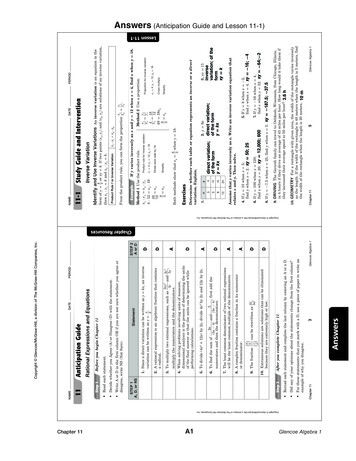
Transcription
AMERICAN JOURNAL OF PHYSICAL ANTHROPOLOGY 144:215–225 (2011)Metacarpal Trabecular Architecture Variationin the Chimpanzee (Pan troglodytes): Evidencefor Locomotion and Tool-Use?Richard A. Lazenby,1* Matthew M. Skinner,2 Jean-Jacques Hublin,2 and Christophe Boesch31Anthropology Program, University of Northern British Columbia, Prince George, BC,Canada V2N4Z92Department of Human Evolution, Max Planck Institute for Evolutionary Anthropology,04103 Leipzig, Germany3Department of Primatology, Max Planck Institute for Evolutionary Anthropology,04103 Leipzig, GermanyKEY WORDSPan troglodytes; microcomputed tomography; metacarpal trabecular architecture;knuckle-walking; nut-crackingABSTRACTTrabecular architecture was assessedby 3D micro-computed tomography from spherical volumes of interest located within the head and base ofmetacarpals (MC) 1, 2, and 5 from n 5 19 adult common chimpanzees. Two subspecies, West African Pantroglodytes verus from the Taı̈ Forest, Côte d’Ivoire (n5 12) and Central African P. t. troglodytes from Cameroon (n 5 7), were studied. For the combined sample,the metacarpal head is distinguished by greater bonevolume fraction across all metacarpals, though the MC1 is distinctive in having thicker, more plate-like trabeculae. The architecture in the MC 2 and MC 5 can berelated to strains associated with terrestrial knucklewalking. In particular, the relatively robust MC 5 headarchitecture may result from functional loadingincurred during braking and use of a palm-in hand posture. Examining differences between samples, we foundthat the Cameroon chimpanzees possess a more robustarchitecture across all metacarpals in the form ofgreater bone volume fraction, higher connectivity, andsomewhat more plate-like structure. These differencesare not explicable in terms of population distinctionsin body size or daily travel distance, but possibly reflecta combination of more terrestrial knuckle-walking inthe Cameroon sample and more diverse hand posturesand precision handling required of nut-cracking inWest African chimpanzees. Am J Phys Anthropol144:215–225, 2011. V 2010 Wiley-Liss, Inc.Two functional enterprises dominate the use of thehominoid upper limb: locomotion and manipulation.The impact of locomotion on long bone morphologyand cross-sectional geometry has been well-studied(Ruff and Runestad, 1992; Demes et al., 2001; Ruff,2002; e.g., Carlson et al., 2006; Zihlman et al., 2008),while behavioral variation (e.g., tool use) has receivedless attention (e.g., Morbeck et al., 1994; Sarringhauset al., 2005). To date, comparatively few studies haveaddressed the relationship between skeletal anatomyand primate locomotion through an examination oftrabecular morphology, and fewer have ventured toconsider the impact on trabecular bone of differencesin manipulation (Zylstra, 2000; Lazenby et al., 2008c).This study investigates variation in trabecular massand architecture in samples of first, second, and fifthmetacarpals of Western (Pan troglodytes verus) andCentral African (Pan troglodytes troglodytes) commonchimpanzees, using noninvasive 3D microcomputed tomography (lCT). Specifically, it assesses variation intrabecular structure within and between each metacarpal and tests hypotheses linking trabecular architecture to both locomotor repertoire and degree ofmanual manipulation, as well as testing for subspecificdifferences.Trabecular bone is well suited to the study of functional adaptation (Ruff et al., 2006) as it is highly responsive to variation in its mechanical environment,particularly through the growth phase (Ducher et al.,2006; Pontzer et al., 2006). As a tissue, trabecular bonehas received considerable research within biomedicineand biomechanics, emphasizing the relation of propertiesof volume, mineral density, and structure to materialproperties such as strength, stiffness, and resistance tofailure (Haddock et al., 2004; Renders et al., 2008). Atthe microstructural level, studies have demonstratedthat the amount of trabecular bone (characterized asbone volume fraction) is a robust predictor of structuralstrength measured as Young’s modulus (e.g., Bevillet al., 2006). Moreover, specific architectural featuressuch as trabecular number, thickness, orientation, anddegree of ‘‘plate-ness’’ versus ‘‘rod-ness’’ have been shownC 2010VWILEY-LISS, INC.CGrant sponsor: Natural Science and Engineering Research Council of Canada; Grant number: 183660-03; Grant sponsor: EVANMarie Curie Research Training Network; Grant number: MRTN-CT019564; Grant sponsor: Max Planck Society.*Correspondence to: Richard A. Lazenby, Ph.D., AnthropologyProgram, University of Northern British Columbia, 3333 UniversityWay, Prince George, BC, Canada V2N4Z9. E-mail: lazenby@unbc.caReceived 12 September 2009; accepted 6 July 2010DOI 10.1002/ajpa.21390Published online 24 September 2010 in Wiley Online Library(wileyonlinelibrary.com).
216R.A. LAZENBY ET AL.to contribute to the ability of trabecular bone to withstand functional loads (Ruimerman et al., 2005a). Current research suggests that trabecular bone responds tolarge functional loads through an increase in trabecularnumber, thickness, and ‘‘plate-ness,’’ contributing to alarger bone volume fraction (Stauber and Müller, 2006;Stauber et al., 2006). Moreover, orientation of trabecularrods and plates correlates with load direction, such thatloading diversity results in more isotropic trabecular volumes. Finally, axial loads tend to be borne preferentiallyby plate-like elements, which have a higher stiffness andresistance to failure (Stauber and Müller, 2006).Given the now well-recognized variation in behavioraldiversity among chimpanzees (Boesch and Tomasello,1998; Whiten, 2007) and the sensitivity of trabecularbone to functional loading noted above, the possibility ofdiscerning an osseous signal for locomotion and/or tooluse at the microstructural level in forms such as Panshould be considered. In chimpanzee terrestrial or arboreal knuckle-walking, body weight, and momentum combine to generate significant biomechanical loads amongdigits, which are highest in the second and third raysand reduced by about 50% in rays four and five; the firstmetacarpal is effectively isolated (Wunderlich andJungers, 2009). These loads have been estimated atabout 20% body weight in terrestrial knuckle-walking,and up to twice body weight in one-handed suspension(Preuschoft, 2004).We hypothesize that trabecular architecture will showa lateral to medial (II–V) gradient in declining strengthwithin the palm, with the first metacarpal least robust.Within a biomechanical framework, we predict that elements most heavily loaded in locomotion will presentwith higher trabecular volume and an architecturefavoring a preponderance of thick, well-connected, andanisotropic plates. Significant head versus base differences have been noted for the human second metacarpal(Lazenby et al., 2008a), largely explicable by the greaterdegrees of freedom and subsequent loading diversityexperienced by the distal epiphysis. Thus, a second hypothesis is that the distal and proximal epiphyses willalso differ as a consequence of variation in loading pattern (independent of magnitude) associated with jointstructure.While locomotion contributes most to functional loading in the chimpanzee forelimb, the well-recognized cultural repertoire expressed by Pan implies that variationin manipulative roles may produce unique biomechanicalsignals mediating trabecular bone morphology. The moststriking behavioral distinction among the various common chimpanzee populations in western, central, andeastern Africa is the propensity for western chimpanzees(Pan troglodytes verus) to use large wood or stone hammers to crack nuts as a typical subsistence strategy(Boesch et al., 1994; McGrew et al., 1997). The energyinvolved in nut-cracking with regard to time spent,weight of hammer employed, and frequency of act can besubstantial (Boesch and Boesch-Achermann, 2000), suggesting not only that it is adaptive but that it alsoimparts nontrivial mechanical loads. Boesch and Boesch(1993) documented a variety of grips and hand posturesused in positioning nuts on anvils, or holding nuts forsubsequent processing. The thumb is directly involved inthe majority of these grips and postures in both unimanual (arboreal nut processing with smaller hammers) orbimanual (terrestrial activity with hammers as large as20 kg; (see Boesch and Boesch, 1993; their Figs. 5, 7,American Journal of Physical Anthropologyand 8). As such we hypothesize that the first metacarpal,isolated from locomotory activity (see below) but frequently recruited in manipulation, will possess a trabecular architecture reflecting such behaviors. We predictthat P. t. verus MC 1 architecture will be characterizedby greater isotropy and a bone volume fraction composedof more numerous rod-like trabeculae compared to thatfound in P. t. troglodytes.MATERIALS AND METHODSSeventy-nine first, second, and fifth left and rightmetacarpals were selected from 17 adult and 2 late adolescent chimpanzees. Of these, 12 are West African P. t.verus from the Taı̈ National Park, Côte d’Ivoire, (curatedat the Max Planck Institute for Evolutionary Anthropology, Leipzig), and 7 specimens from southern Cameroonhoused at the Museum für Naturkunde (Berlin). The latter typically date to the early 20th c., and are likely P. t.troglodytes (surmised from geographic references notedby the collector, e.g., ‘‘Akonolinga, Afrika’’ or ‘‘Sangmelima, Kamerun’’). The Taı̈ sample comprises a numberof known individuals, many of which have been the subject of long-term ethological study including researchconcerning handedness and tool-using behavior (Boesch,1991; Boesch and Boesch-Achermann, 2000). Of the 19individuals in the combined sample, 10 were identifiedas female and 8 male; one of the Cameroon specimenswas catalogued as ‘‘unknown sex,’’ though standardosteometric measures (data not reported) lead us to conclude that this individual is female. Seven individualscontributed complete sets of paired metacarpals, withthe remainder supplying one or two pairs. Unpaireddata were collected for some metacarpals from five animals due to absence or postmortem damage to the contralateral element. With the exception of one adultfemale from the Taı̈ sample, all forelimbs were free ofmanifest pathology. This individual exhibited a moderatedegree of myositis ossificans of the volar surface on theleft second metacarpal just distal to midshaft. However,one-sample t tests (not reported) failed to demonstratesignificant differences from the nonpathological samplefor any trabecular variable; consequently, we haveincluded these data in subsequent analyses.Heads and bases were scanned using a SkyScan (Aartselaar, Belgium) 1172 Desktop lCT Scanner (parameters:100 kV, 0.094 mA, 0.5-mm aluminum filter, 0.5-rotationstep, 3608 of rotation, two frame averaging). Raw projections were converted into TIFF image stacks using NRecon1 (parameters: ring artifact correction 5 5; beam hardening 5 50%). Pixel dimensions and slice spacing of theresultant images was 14 microns (lm). Trabecular massand architecture was characterized from 4.5-mm diameterspherical volumes of interest (VOI; Fig. 1) using CTAn1and a global thresholding algorithm (Lazenby et al.,2008b). The VOI was located centrally within the proximaland distal epiphyses1 with the mid-slice positioned suchthat all slices in the stack included only trabecular bone.The specific global threshold value demarcating the bone–nonbone interface varied for each VOI, and was determined with reference to the gray-level histogram generated over all of the slices in the stack. In each case the1The 1st metacarpal does not have an epiphysis per se (i.e.,occurring as a separate center of ossification). We use the termhere as a convenient reference to anatomical location of the proximal and distal subarticular masses.
CHIMPANZEE METACARPAL TRABECULAR ARCHITECTUREthreshold was determined as the minimum inter-peakvalue from the histogram, with all voxels below this valuespecified as background and those above as bone.The variables analyzed include measures of relativebone mass, strength, and structure (Table 1). As we foundno evidence for significant directional asymmetry or sexualdimorphism for trabecular morphology in this sample,side, and sex were combined in the present study. The absence of sexual dimorphism is consistent with previousresearch suggesting a lack of body size dependence for features of trabecular size such as thickness (Swartz et al.,1998), though parameters such as connectivity and number did vary when viewed over several orders of magnitudesize change. Thus, scaling of trabecular skeletal parameters to standardize for body size, typically performed foranalysis of diaphyseal cortical bone structure (Ruff, 2000),was not deemed necessary for the present study given therelatively small size range sampled. General patterns ofvariation between epiphyses and elements for the entiresample (P. t. verus and P. t. troglodytes combined) wereexamined using a nested analysis of variance (epiphysisnested within element); post-hoc pairwise comparisons forFig. 1. First, second, and fifth metacarpals (left to right, headinferior) showing the placement of the volume of interest (VOI).217significant ANOVA results were assessed by the Scheffétest. Comparison of the Pan t. verus and Pan t. troglodytessamples, in which we explore the impact of behavioral differences, was undertaken using a Kruskal-Wallis nonparametric ANOVA given the attendant reduction in samplesize. All analyses were carried out using Systat 11.0 and a5 0.05. In the following Results and Discussions sectionswe first present findings for the combined sample, followedby the between-population analyses.RESULTSGeneral patterns of variationDescriptive statistics for the combined Taı̈ and Cameroon samples are given in Table 2. Nested ANOVA (Table3) reveal differences in trabecular architecture betweenhead and base for all variables, and the significant interelement differences (BV/TV, Tb.Th, Tb.N, Tb.Sp, and DA)are consequential to epiphyseal differences. An exampleis the distinction in BV/TV for the MC 1 head comparedto its base (16.50% vs. 12.69%). The pollical distal VOIhas a significantly larger bone volume fraction, due togreater trabecular thickness (Tb.Th) rather than number(Tb.N), than any of the other heads or bases with theexception of the MC 5 head (Table 4). Among elements,the 2nd metacarpal head has significantly lower BV/TV.It is notable that across all three of the metacarpals, thedistal VOI invariably has a greater bone volume fractionthan its corresponding base (see Fig. 2).Figure 3 summarizes the pattern of variation amongepiphyses and elements. The MC 1 presents clear distinctions with the head having significantly higher connectivity than the base (Scheffé post-hoc P 5 0.01; 147df) and a greater proportion of plate-like trabeculae relative to the base (Scheffé post-hoc P 5 0.04; 147 df).Indeed, the average connectivity for the MC 1 head isthe lowest among all VOIs at 0.32 6 0.44. These variations in structure are clearly evident in comparing 3Dsurface models of the epiphyseal VOIs for MC 1 versusMC 2 (see Fig. 4). A consequence of these architecturaldifferences in Tb.Pf and SMI is the illusion that the distal MC 1 has a lower bone volume fraction, but as notedTABLE 1. Trabecular variables selected for analysisVariableBone volume fractionTrabecular bone pattern factorStructure model indexSymbol (unit)DefinitionBV/TV (%)The proportion of the total volume of theVOI occupied by trabeculae.A proxy measure trabecular connectivity within a VOI.Higher Tb.Pf values indicate greater fragmentationand the presence of isolated struts; lower values reflectstructural integrity and greater connectivity.SMI is a dimensionless measure of the relativeproportion of plate-like versus rod-like structures in the VOI.Values range from 0 (idealized plates) to 3 (idealized rods).The mean minimum thickness of trabeculae in aVOI summed over all local voxels (3D pixel elements)based on the diameters of a series of spheres fullycontained within the structure.The ratio of bone volume fraction to trabecular thickness.The average width of the spaces between adjacent trabeculae in a VOI.DA describes trabecular orientation. Anisotropic structureshave a preferred orientation while isotropic structuresdemonstrate symmetry of orientation in 3D space.CTAn employs the mean intercept length (MIL) algorithmfor calculating DA. Anisotropy values are reported as adimensionless value ranging from 0 (fully isotropic) to 1 (fully anisotropic).21Tb.Pf (mm)SMITrabecular thicknessTb.Th (mm)Trabecular numberTrabecular separationDegree of anisotropyTb.N (mm21)Tb.Sp (mm)DAFull descriptions and calculation protocols are available from http://www.skyscan.be/next/CTAn03.pdf.American Journal of Physical Anthropology
218R.A. LAZENBY ET AL.TABLE 2. Means and standard deviations for the complete sample, by element and epiphysisBVTVMCMCMCMCMCMCI head (n 5 20)I base (n 5 23)II head (n 5 29)II base (n 5 27)V head (n 5 27)V base (n 5 ABLE 3. Results of nested ANOVA, epiphyses within .940.010.006.5716.230.000.003.232.920.040.04TABLE 4. Scheffé post-hoc probabilities by epiphysis for BV/TVMC 1 B MC 1 H MC 2 B MC 2 H MC 5 B MC 5 .000.020.210.620.120.010.940.430.93Significant differences are in bold.above, BV/TV is actually greater at this site than elsewhere as the more plate-like trabeculae are muchthicker.While the 2nd and 5th metacarpals are similar inmany respects, the MC 2 head and base have thinnerand fewer trabeculae per unit volume, contributing togreater trabecular spacing and lower BV/TV. In themetacarpal heads, values for DA range from 0.35 to 0.38moving from 1st to 5th metacarpals; that is, the 5thmetacarpal distal epiphysis has more preferentially oriented trabeculae, though the differences are not statistically significant. Among bases, the proximal MC 2 (DA5 0.36) is more isotropic than either the MC I or MC 5(significantly more so in the case of the latter). Thegreater trabecular isotropy in the MC 2 base may be dueto its more complex carpometacarpal arthroses and themultiplanar facet morphology of the proximal epiphysis(Tocheri et al., 2005). This would favor a trabecularstructure able to accommodate loading from multipledirections.Interpopulation variationValues for the Taı̈ and Cameroon samples are reportedin Tables 5 and 6 while Tables 7 and 8 provide results ofthe Kruskal-Wallace ANOVA. Across VOIs the Cameroonsample has a significantly greater bone volume fraction(BV/TV), with the exception of the MC 2 and MC 5bases, though the former approaches significance (v2 53.43; P 5 0.06). This difference is especially marked forthe MC 2 and MC 5 heads, and the MC 1 base. The primary contributors here are SMI and Tb.Th. The CentralAfrican chimpanzees have a greater proportion of thick,plate-like trabeculae, which add to a higher degree ofconnectivity and bone volume fraction. While the Cameroon chimpanzee metacarpals tend to have more trabeculae in both head and base, the differences are not thatpronounced (as shown by Tb.Sp). There are also insubAmerican Journal of Physical AnthropologyFig. 2. Inter-element differences in BV/TV (mean 1 sd). Thehead is consistently greater than its corresponding base; that ofthe MC 1 is significantly larger than all other instances withthe exception of the MC 5 head (see Table 4).stantial differences in the degree of anisotropy amongthe volumes of interest between the two populations.Regardless of structural variation (i.e., plates or rods),the samples do not deviate markedly in terms of preferred trabecular orientation.Examining the populations separately clarifies thegeneral patterns of variation noted above. For example,the distal VOI invariably having greater BV/TV than itscorresponding base can be ascribed to the influence ofthe Cameroon sample, as this distinction does not occurfor the MC 2 and MC 5 among Taı̈ chimpanzees. If fact,in the Taı̈ sample, the MC 5 base has a larger (albeitnonsignificant; t 5 1.26; P 5 0.22) bone volume fractionthan in the head. Similarly, while both populations possess greater trabecular connectivity (Tb.Pf) and a moreplate-like structure (SMI) in the MC 1 head relative toits base (contrary to our prediction), these distinctionsare more pronounced for the Cameroon sample. Indeed,with a SMI value of 0.01 6 0.44 for the MC 1 head VOI,P. t. troglodytes approaches the value for idealizedplates.DISCUSSIONGeneral patterns of variationTrabecular architecture in Pan troglodytes varies inmass and structure between head and base across meta-
CHIMPANZEE METACARPAL TRABECULAR ARCHITECTURE219Fig. 3. Plots for architectural variables by ‘‘epiphysis’’ and element (mean 6 sd). The pattern of MC 1 head and base differencesis clearly distinct from that of the 2nd and 5th metacarpals.carpals 1, 2, and 5. These differences are most markedin the MC 1 and most apparent with respect to BV/TVand its contributing architectural features (e.g., SMI andTb.Th for MC 1 and Tb.Sp and Tb.N for MC 2 and MC5). Lazenby et al. (2008a) reported a similar head versusbase dichotomy for the human second metacarpal, againprincipally expressed in terms of bone volume fraction,reduced spacing, and increased trabecular number. Theyattributed that pattern to a more dynamic and diverseloading history experienced by the less anatomically constrained head. A similar argument applies in the presentcase for Pan, in particular for MC 2 and MC 5, in whichthe carpometacarpal arthroses limit range of motion andenhance stability during knuckle-walking (Marzke andShackley, 1986; Tocheri et al., 2003). Preuschoft (1973)emphasized this point in considering the metacarpalsand carpals as a unified functional unit. The presentstudy also found that the Pan pollical metacarpal standsAmerican Journal of Physical Anthropology
220R.A. LAZENBY ET AL.out in having trabecular architecture in the head whichis quantitatively and qualitatively distinct from thatfound in the MC 1 base or in the palmar elements, notably having much thicker, more plate-like trabeculae.Both of these principal findings speak to variation inrobusticity and strength of these elements in relation totheir primary modes of functional loading (locomotionversus manipulation).Why is MC 5 more robust than MC 2?We had hypothesized that the MC 2 would have amore robust architecture than the MC 5 given itsgreater loading in knuckle-walking progression. However, the fifth metacarpal has greater bone volume fraction than the second, in both head and base, primarily aconsequence of higher values for Tb.N and Tb.Th (seeFigs. 2 and 3), parameters that have been shownthrough finite element analysis to reflect increased functional loading (Ruimerman et al., 2005a). This may beexplicable in light of particular characteristics of theFig. 4. The 3D renders of head and base VOIs for the 1stand 2nd metacarpals from an adult female chimpanzee. The 5thMC generally mimics the structural pattern of the 2nd MC.locomotor dynamics of chimpanzees. Pan locomotor andpostural repertoires can best be described as complexand diverse (Hunt et al., 1996). Carlson et al. (2006)documented four primary locomotor modes for P. troglodytes: quadrupedal walk, quadrupedal climb, quadrupedal scramble, and suspension, the last three arborealactivities. Climbing, scrambling, and suspensory activitytypically involves a ‘‘hook-grip’’ involving digits two tofive (Marzke and Wullstein, 1996). As noted by Preuschoft (2004), arboreal locomotion, particularly suspension, subjects palmar metacarpals to a net compressiveforce which may result in greater strain magnitudesthan that experienced in terrestrial knuckle-walking.Although locomotion constitutes only a small portion ofchimpanzee activity schedules [less than 16% of observedactivities involved locomotion for either males orfemales, and about 85% of these behaviors were recordedas terrestrial knuckle-walking (Carlson et al., 2006)], theMC 5 will be under some (at present unknown) level offunctional loading in vertical climbing and/or suspension.Recent qualitative and quantitative kinetic and/or kinematic studies in Pan and Gorilla have identified anumber of important distinctions relevant to understanding metacarpal trabecular structure, both functionally in terms of hand posture and peak force distributionamong digits (Wunderlich and Jungers, 2009), as well asontogenetically, particularly regarding the variablerecruitment of the fifth ray in knuckle-walking in subadult (Inouye, 1994) and adult (Tuttle, 1969) chimpanzees. Matarazzo (2008, 2009) demonstrated that the 3rddigit experiences the highest compressive pressures during knuckle-walking in chimpanzees and gorillas,regardless of how many other digits contact the substrate. Chimpanzees also evinced greater variability inhand posture in locomotion. Wunderlich and Jungers(2009) reported peak pressures and contact sequencedata in knuckle-walking for digits two to five for a small(n 5 2) chimpanzee sample. They found that peak pressures varied by forelimb placement (inside or outside ofthe advancing ‘‘overstriding’’ hindlimb) as well as handposture. Hand posture contrasted a ‘‘palm-in’’ (semi-pronated) versus ‘‘palm-back’’ (fully pronated) orientation.Both postures are used regularly, though palm-in wasmore commonly employed when walking on the ground.TABLE 5. Taı̈ forest sample means and standard deviationsBVTVMCMCMCMCMCMCI head (n 5 12)I base (n 5 11)II head (n 5 18)II base (n 5 18)V head (n 5 15)V base (n 5 x and side combined; see Table 1 for units of measurement.TABLE 6. Cameroon sample means and standard deviationsBVTVMCMCMCMCMCMCI head (n 5 8)I base (n 5 10)II head (n 5 11)II base (n 5 9)V head (n 5 12)V base (n 5 0.280.450.54Sex and side combined; see Table 1 for units of measurement.American Journal of Physical )
221CHIMPANZEE METACARPAL TRABECULAR ARCHITECTURETABLE 7. Kruskal-Wallace ANOVA for population differencesin the metacarpal headBV/TVTBPFFirst metacarpal5.726.48v2P50.020.01Second metacarpal16.0017.47v2P50.000.00Fifth .352.140.140.120.73Significant differences are in bold.In this posture, initial contact with the substrate ismade with the 5th digit, though the second and thirdrays experience significantly higher peak pressures asthe hand rolls over to complete the loading cycle and theanimal’s center of mass (COM) moves over the extendedforelimb. In the palm-back posture, peak pressures aredistributed across digits two to four, and digit five againexperiences significantly lower loading. However, Wunderlich and Jungers (2009) note that the animal’s agemodified the pattern of loading—at a younger age, thesubject animals had higher peak pressures for digitsthree and four, though when older, the highest loading(for both postures) occurred for digit two, closely followedby digit three; loading of digit five was about 25–33%that of digit two (e.g., 20 N cm22 vs. 60–80 N cm22, theirFig. 8b). Importantly, Doran (1997) has noted that adultlocomotor behaviors in Pan are established during thetransition from infancy to juvenile life stages, some 6–8years before completion of skeletal growth.A further consideration for the present study is disparityin forelimb and hindlimb force and weight support whenbraking during locomotion. Demes et al. (1994) reportedgreater braking force for the forelimb than the hindlimb inwalking and galloping. While more of body mass is accommodated by the hindlimb in chimpanzees during locomotion (Demes et al., 1994; Raichlen et al., 2009), dynamicloading associated with deceleration is born primarily bythe forelimb. This suggests the hypothesis that the difference in braking force may account for the relatively hightrabecular robusticity in the head of MC 5 seen in thepresent study. This could occur because bone modeling issensitive not only to strain magnitude, but even more so tostrain rate (Martin et al., 1998; Ruimerman et al., 2005b).The braking hypothesis would be particularly relevant inthe case of palm-in postures in which initial substrate contact is borne by the head of the MC 5. Wunderlich andJungers (2009) found that the highest peak pressures forthe 5th digit occurred for the palm-in posture during theinitial contact
umes. Finally, axial loads tend to be borne preferentially by plate-like elements, which have a higher stiffness and resistance to failure (Stauber and Mu ller, 2006). Given the now well-recognized variation in behavioral diversity among chimpanzees (Boesch and Tomasello, 1998; Whiten, 2007) and the sensitivity of trabecular
